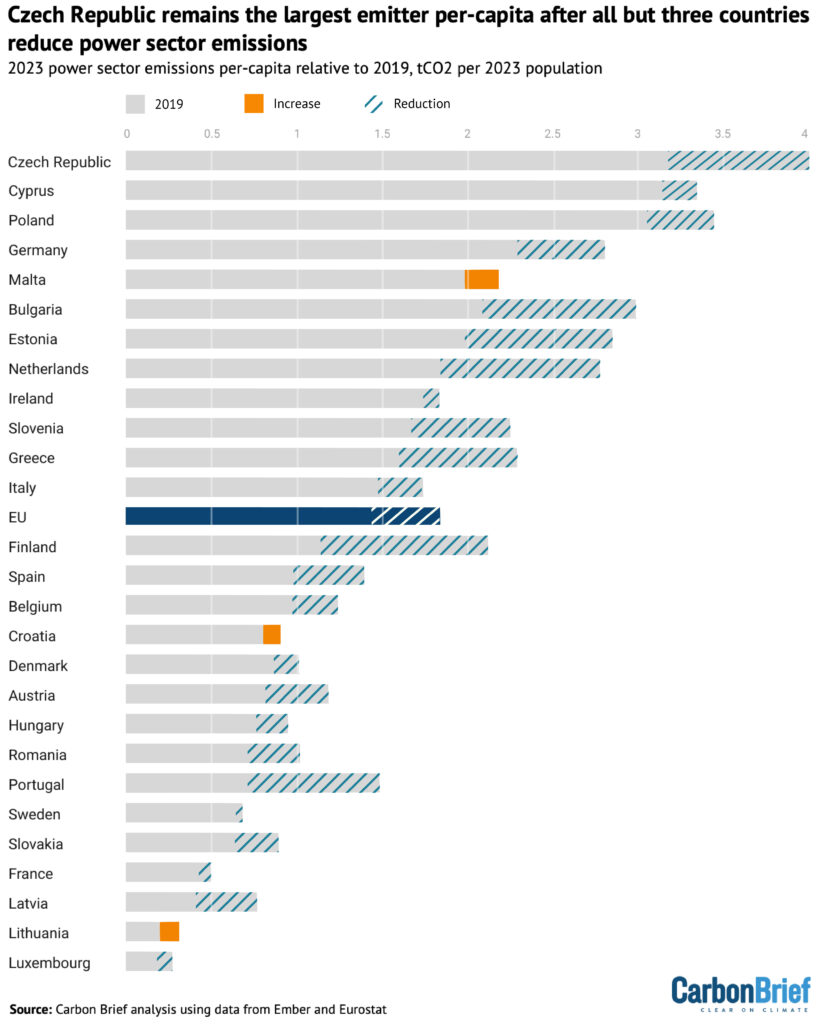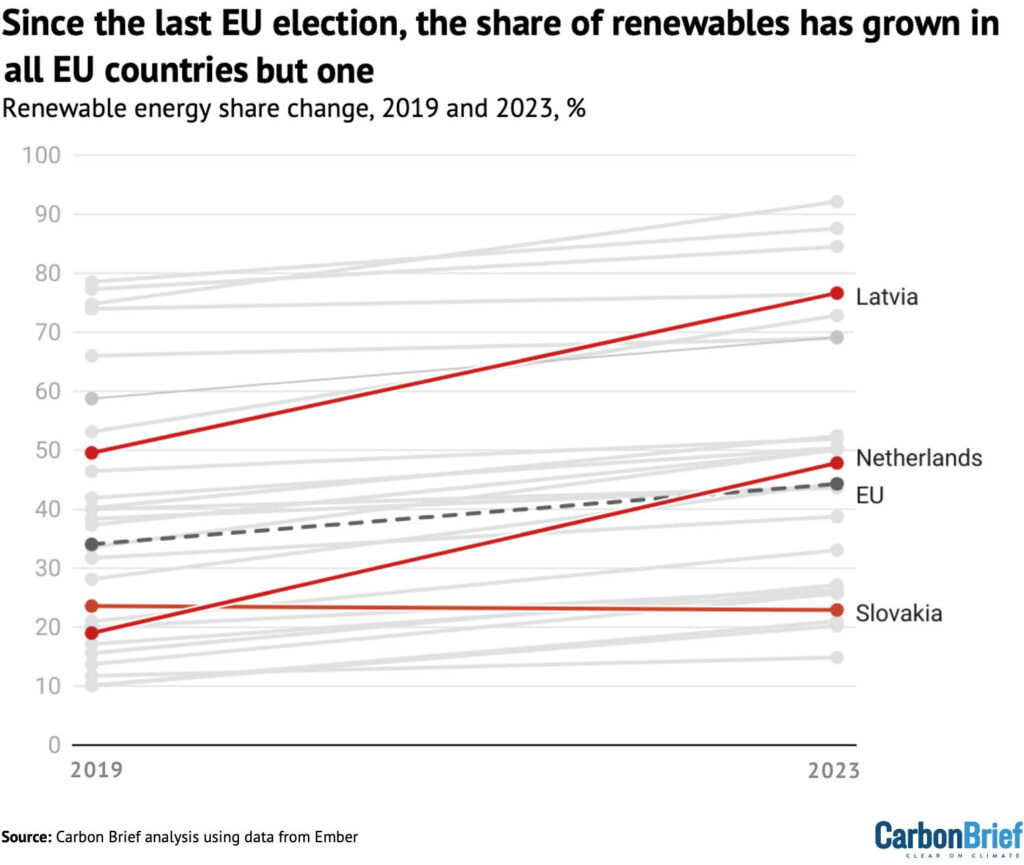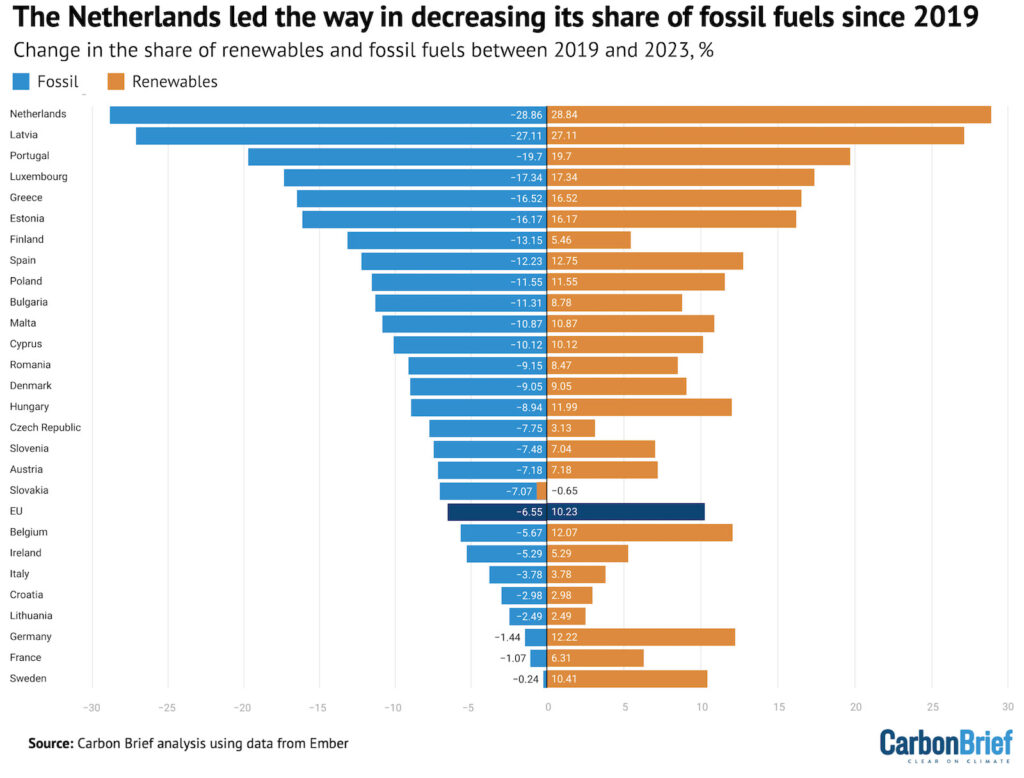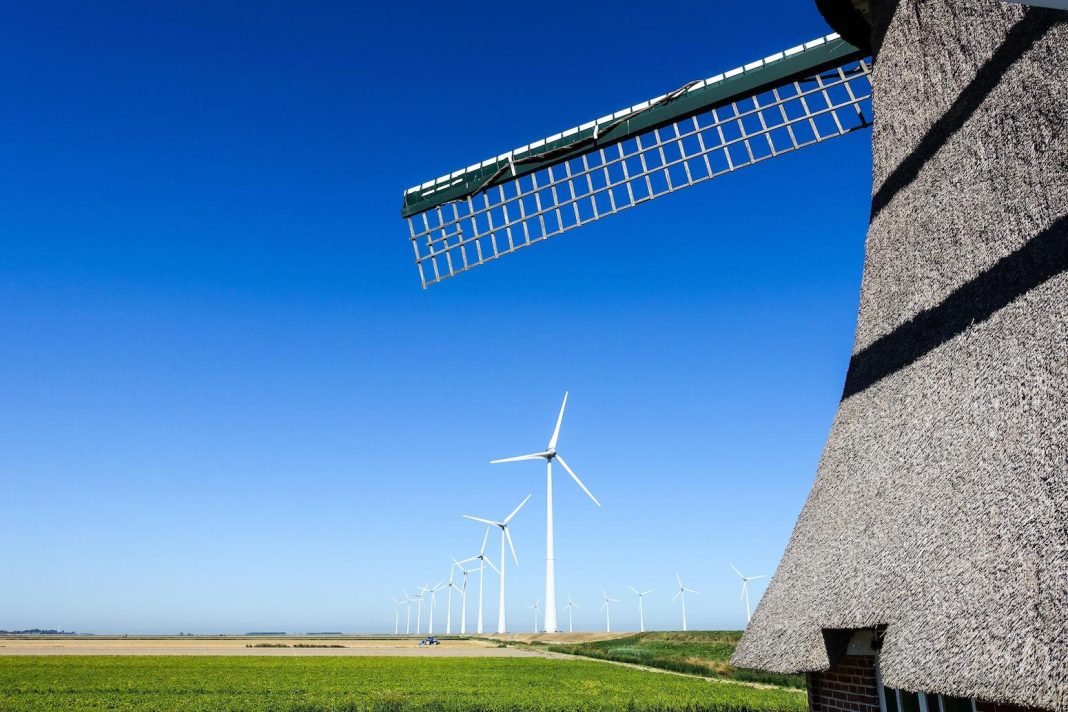Power-sector emissions have fallen by 20% across the EU since the last European parliamentary election in 2019, according to Carbon Brief analysis.
Between 6-9 June, around 360 million people across the EU will vote for representatives from national parties to sit in the European Parliament.
The grouping or coalition with the most seats will help to shape the leadership of the next European Commission. The overall composition of parliament will also influence the bloc’s priorities between 2024-2029.
Climate change and energy once again feature prominently in the manifestos of the major parties, with mounting pressure to secure energy supplies in the wake of Russia’s invasion of Ukraine drawing particular focus.
Core to this is a transition to decarbonised domestic energy. Carbon Brief’s analysis shows that the relatively small nations of Portugal, Latvia and Finland have led the way since the last EU election, with the largest percentage drop in power-sector emissions between 2019 and 2023.
Malta and the Netherlands have led in increasing their renewables shares, with the Netherlands also seeing the largest absolute increase in renewable generation.
Meanwhile, fossil-fuel generation fell in all but three countries when comparing 2019 and 2023.
Other key findings from the analysis include:
- All national power systems across the EU are cleaner than in 2019, with EU renewables share increasing from 34% in 2019 to 44% in 2023.
- Germany saw the largest fall in power-sector emissions in absolute terms since the last EU emissions.
- There were just three EU countries where fossil fuel use has increased since 2019 – Malta, Croatia and Lithuania.
- The Czech Republic remains the biggest per-capita emitter in the EU, but per-capita emissions fell in all but three countries.
- Overall, all of the EU’s power systems have become cleaner since 2019, with the most carbon-intensive grid (Poland) making the fourth most progress in absolute terms.
- Malta and the Netherlands have increased their renewables share by more than 150% relative to 2019.
- Spain added the most solar generation in absolute terms. Poland increased its solar generation by more than 1,500%, increasing generation by 12TWh.
In this analysis, Carbon Brief looks at how the electricity sector has changed since the last election.
All of the EU’s power systems cleaner than 2019
Every national power system across the EU has become cleaner since the last European Parliamentary election in 2019, Carbon Brief analysis shows.
Finland led the way in terms of reducing grid intensity – the measure of how clean the electricity within national grids is – halving its intensity between 2019 and 2023 to become the third cleanest in the EU, behind France and Sweden.
In absolute terms, Greece reduced its grid intensity the most since 2019, Carbon Brief shows. The country hit a new record high level of clean energy generation, with power grid operator IPTO announcing that renewables and hydroelectric plants accounted for 57% of the country’ energy in 2023.
Germany saw the largest fall in power-sector emissions in absolute terms – namely, the overall volume of CO2 emissions produced. Like Greece, the country had a “landmark” 2023 for renewable generation, according to thinktank Ember.
Carbon Brief analysis shows that power-sector emissions in Germany fell by 43.23m tonnes of carbon dioxide (MtCO2), or 18.4%, of 2019 values by 2023.
Despite this significant drop, the country’s power sector is still the most polluting of all EU countries, responsible for 29.3% of EU power-sector emissions. This places it far ahead of Poland, the second largest polluter, which is responsible for 17% of emissions.
Germany has one of the largest populations in Europe and its energy demand sits at 514TWh (19% of EU total). When looking at per-capita emissions (as shown below), the country sits fourth in the EU for emissions, seeing a reduction of 0.51tCO2 in 2023 compared with 2019.
Portugal, Latvia and Finland decarbonised their power sectors the most relative to 2019, analysis shows.
Portugal saw renewables supply 61% of its electricity consumption in 2023, according to the country’s grid operator Redes Energéticas Nacionais. This totaled 31.2TWh – the most it has ever recorded. This included a period in November where the country ran on just renewables for six days in a row.
Carbon Brief’s analysis of Ember data placed the 2023 figure even high, with 73% of electricity from renewable sources.
As shown in the chart below, there were just three EU countries where power-sector emissions have increased since 2019 – Malta, Croatia and Lithuania. These countries are some of the smallest in Europe, collectively accounting for less than 1% of total EU power generation in 2023.
Malta increased its power-sector emissions by 0.11MtCO2, or 10.3%, of 2019 emissions. As an island nation, Malta’s energy system is still heavily dominated by imported oil and gas, making up nearly 90% of power generation. (Malta has some of the lowest per-capita emissions in Europe, with 5.3 tonnes CO2 equivalent (tCO2e) per inhabitant in 2019, well below the EU average of 8.4tCO2e.)
Croatia, where emissions increased by 0.4MtCO2 or 13%, is similarly reliant on fossil fuels, with coal still dominating its power sector. While power demand has remained stable in recent years, net imports of electricity have dropped likely due to higher electricity prices in neighbouring countries.
Although renewable generation offset most of this, it did lead to a small jump in fossil fuel use of ~1TWh.
Lithuania saw emissions increase by 0.32MtCO2, from 0.57MtCO2 in 2019 to 0.89MtCO2 in 2023, Carbon Brief analysis shows. The country is currently heavily reliant on electricity imports, after the closure of its only nuclear power plant in 2010 changed it from a net exporter to a net importer.
Chris Rosslowe, senior energy and climate data analyst at Ember, tells Carbon Brief:
“Trends in generation in Lithuania don’t tell you as much as in other countries as it imports most of its electricity since shutting down nuclear power in 2010. Import dependence is slowly lowering though – from ~75% in 2019 to ~55% in 2023 – and, like Croatia, renewables are growing faster than fossils.”
It is undergoing a particularly key period of transition. Lithuania’s electricity grid currently operates synchronously with the Russia-Belarus power system, but it is planning to de-synch by 2025 and instead run with the continental Europe grid.
Additionally, it is among the countries that are seeing the fastest expansion of wind generation. It is also targeting halving its imports and generating 70% of its electricity from domestic sources by 2030, as it pushes for increased energy sovereignty and security.
Rosselowe notes that Malta, Croatia and Lithuania are all expected to reduce their dependence on fossil fuels in the coming years, offset in large part by growing renewables.
Overall, the Czech Republic remains the biggest per-capita emitter in the EU, as shown in the chart below. Between 2019 and 2023, emissions in the country did drop from 4tCO2 to 3.2tCO2, but it still sits 0.9tCO2 above the second highest per-capita emitter Cyprus (3.1tCO2).

The three countries that saw an increase in per-capita emissions match those where there was an increase in fossil fuel generation – Malta, Croatia and Lithuania.
Renewable generation grows in all but one country
Between 2019 and 2023, the share of renewable generation in the EU increased in all by one country, according to Carbon Brief analysis.
Italy saw renewable generation fall from 115.83 terawatt hours (TWh) in 2019 to 114.8TWh in 2023. This was broadly due to the impact of droughts in the country affecting hydropower generation, which hit in 2022, but had a continued impact in 2023.
This was a wider dynamic seen globally, which kept the world from hitting peak electricity generation emissions in 2023.
Slovakia, meanwhile, was the only country to see a dip in its share of renewable energy when comparing 2019 and 2023. This was minor, falling just 0.65% from 23.57% to 22.92%. The country has one of the smallest energy demands in Europe and, like Italy, saw a drop in hydro driven by droughts in 2022.
Malta and the Netherlands saw their share of renewables increase by more than 150% in 2023 relative to 2019, Carbon Brief analysis shows.
The Netherlands increased its absolute share of renewable generation by close to 30% since 2019, as shown in the chart below. The country seeing the largest absolute increase in renewable generation, closely followed by Spain.

Nearly half the electricity produced in the Netherlands is now renewable, according to the Dutch Central Bureau for Statistics.
This was predominantly wind generation, with the country adding more wind power than any other country in the EU between 2019 and 2023, both relatively and in absolute terms. Overall, the Netherlands increased its wind generation by 152% and Finland followed closely behind with a 143% rise.
Latvia, similarly, saw significant growth, with the share of renewables jumping from 49.5% in 2019 to 76.6% in 2023. This 27.1% increase is particularly key for the country, as it continues to target reducing its dependence on energy imports from Russia.
Spain added more solar generation in absolute terms over the four-year period than any other country in the EU, tripling its overall renewable generation.
Poland increased its solar generation by more than 1,500%, increasing generation by 12TWh albeit from a low starting point of just 0.71TWh in 2019. Renewables generated a record 26% of electricity in the country in 2023. However, coal still produces most of the country’s electricity and continues to have a powerful impact on policy due to powerful lobbies.
Hungary has increased its solar share of generation the most since 2019, with an increase of 14%. It was followed closely by the Netherlands, with a 12.8% increase. Luxembourg increased wind power share of generation by more than the Netherlands – 17%.
Just three EU countries see fossil fuel generation increase
Overall, just three EU countries – Malta, Croatia and Lithuania – saw an increase in the share of fossil fuel generation in 2023 relative to 2019, according to Carbon Brief analysis.
Over the same period, Luxembourg and Finland reduced fossil generation by more than 60%.
The Netherlands has reduced its fossil fuel share in the electricity system the most since 2019, falling by close to 30%. As shown in the chart below, this fall was mirrored by a significant increase in renewable energy generation.

In comparison with 2019, Ireland saw an increase in coal generation in 2023 making it the only EU nation to do so. In 2019, coal generation was at a record low in the country (0.51TWh) before jumping to 2.72TWh in 2022 due to a drop in wind generation.
However, since that point coal power generation has been continuing to fall again, in line with the wider trend seen over the past few decades.
Ireland has seen total electricity demand increase by more than 60% since 2019, Carbon Brief analysis shows. The country’s energy demand has been particularly driven by the growth of data centres, which accounted for 18% of energy demand in 2022, for example.
Despite the blip in coal generation, the share of fossil fuels fell by 2.5% between 2019 and 2023.
Portugal reduced its use of coal the most, relative to 2019, while Germany reduced the most in absolute terms. As discussed above, this was supported by surging renewable generation in both countries.
Pieter de Pous, programme lead in E3G’s fossil fuel transition programme, tells Carbon Brief:
“Europe’s phaseout of coal has been one of its biggest, most historical, monumental success stories of the last couple of years when you think about it. We’ve dropped consumption since 2016 by 50%, right? It’s really enormous and it’s a story that’s rarely told.”
The last European Parliament elections saw a “green wave” of climate-focused politicians winning seats across the continent. In the years that followed, the EU approved a European Green Deal, including goals to cut emissions by 55% from 1990 levels by 2030 and reach net-zero by 2050.
European member states now have a “critical role” to play in implementing what has been agreed, notes Rosslowe. He adds:
“The next legislative agenda is likely to be built around themes of security and competitiveness. The first main task regarding energy and climate for the new parliament will be to appoint a team of commissioners who will tackle these – and any other new policy priorities – in a way that complements rather than competes with the objectives of the Green Deal.”
Sharelines from this story


